Indexed In
- Open J Gate
- The Global Impact Factor (GIF)
- Open Archive Initiative
- VieSearch
- International Society of Universal Research in Sciences
- China National Knowledge Infrastructure (CNKI)
- CiteFactor
- Scimago
- Ulrich's Periodicals Directory
- Electronic Journals Library
- RefSeek
- Directory of Research Journal Indexing (DRJI)
- Hamdard University
- EBSCO A-Z
- Publons
- Google Scholar
Useful Links
Share This Page
Journal Flyer

Open Access Journals
- Agri and Aquaculture
- Biochemistry
- Bioinformatics & Systems Biology
- Business & Management
- Chemistry
- Clinical Sciences
- Engineering
- Food & Nutrition
- General Science
- Genetics & Molecular Biology
- Immunology & Microbiology
- Medical Sciences
- Neuroscience & Psychology
- Nursing & Health Care
- Pharmaceutical Sciences
Research Article - (2021) Volume 11, Issue 4
Fish mediated plankton community dynamics at wastewater-fed fish ponds: A sustainable bio resource management at East Kolkata Wetlands, a Ramsar site (No. 1208)
Abhishek Roy Goswami, Shuvadip Adhikari, Sudin Pal and Subhra Kumar Mukhopadhyay*Received: 26-Feb-2021 Published: 03-Apr-2021
Abstract
Ingenious artisans sustainably converted wastes into wealth using wastewater-fed fish ponds at East Kolkata Wetlands (a Ramsar Site No. 1208) by regulating wastewater inflow and selection of fish of different maturity class. A top-down and bottom-up control exerted by phytoplankton and fish population respectively influenced the zooplankton community structure. The nutritional factors together with fish population significantly influenced the phytoplankton and zooplankton groups. Phytoplankters in nutrient rich wastewater influenced the zooplankton community structure by the way of bottom-up control. Larger fish differently influenced the zooplankton community structure compared to that of smaller ones as these fish with different gape sizes preferred different sizes of prey. Larger phytoplanktivore zooplankters were under top-down control as they were preferred by the fish with larger gape sizes.
Keywords
East Kolkata wetlands; Urban-rural fringe; Plankton; Trophic control; Wastewater-fed fishpond; Ecologically subsidized; Sustainable pisciculture
Introduction
Zooplankton community in freshwater ponds is constituted primarily of rotifers, cladocerans, copepods and ostracods. Zooplankters serve as food for the fish and played a key role in pisciculture operation. Studies highlighting zooplankton-fish dynamics in freshwater ecosystems are undertaken around the globe. The present study is conducted at East Kolkata Wetlands (EKW), a peri-urban natural wetland system, famous for indigenous wastewater-fed pisciculture and contribute a major share of fish production for the Kolkata city. Raw wastewater used in 286 pisciculture ponds, covering nearly 4728 ha water spread area, is sourced from the Storm Water Flow (SWF) and Dry Weather Flow (DWF) channels which transport municipal and industrial wastewaters of Kolkata city traversing through a web of canals inside 12500 ha EKW areas, now designated as Ramsar site (No.1208).
Wastewater-fed fishponds of these wetland areas sustainably produce nearly 10915 metric tons of fish annually. Diversity of zooplankton and their relative abundance at EKW is documented. The relationships between the plankton community and abiotic factors of sewage-fed fishery ponds with a focus on the conceptual model of carbon flow in the EKW fish ponds. It is noted the importance of allochthonous input of nutrients on zooplankton community dynamics [1].
Construct a simulation model of phosphorus dynamics in EKW and point out that the allochthonous input of phosphorus is dominant over autochthonous input and control the system dynamics at the concerned areas. The present study focus on the zooplankton community dynamics influenced by phytoplankton and fish reared in different fish culture ponds (nursery pond, rearing pond and grow-out pond) nurturing fish of different maturity-class to emphasize on the operational pathways that translate ‘phosphorus dynamics’ in ‘system dynamics’ as stated by the end.
The complexity within the zooplanktonic communities generally exists from the presence of fish that might potentially exert strong “top-down” grazing and/or “bottom-up” nutrient effects on aquatic systems. Is there a similar situation prevailed in the wastewater-fed fish ponds of EKW ecosystem! Management of wastewater-fed fish ponds is particularly difficult, however, ingeniously and sustainably tackled by the village artisans through empirical approaches over the last hundred years. Lack of scientific studies that examine the interactions of these phenomena to regulate zooplankton community structure in wastewater-fed fish ponds at the concerned area initiates us to work on the problem. The present study aims at finding out the changes in the zooplankton community in different wastewater- fed fish ponds used to rear fish of different maturity levels [2].
Materials and Methods
Site description
Four wastewater-fed pisciculture earthen ponds in EKW (23º31/58.7//N, 88º25/00.92// E) were selected for the current study (Figure 1). Such Earthen pond culture system had been the conventional method of fish culture in India. The ponds were located about 4 km east of the Eastern Metropolitan Bypass at the South 24 Parganas district of West Bengal near Kolkata city and connected with Storm water flow (SWF) canal that carried raw untreated composite wastewater coming through the Ballygunge pumping station [2,3]. As a practice wastewater was used in the pisciculture ponds as a source of nutrients for phytoplankton and microbial growth and consequently for the development of zooplankton that contributed as fish food. Two species of cichlid fish, Oreochromis mossambicus and Oreochromis nilotica and three Indian major carps, Labeo rohita, Catla catla and Cirrhinus mrigala were cultured in these ponds. However, quick growing Hypophthalmichthys molitrix, Cyprinus carpio etc. were also occasionally cultured in these ponds. Nursery pond was seeded round the year and the hatchling quantities were measured volumetrically in cups (batis) ensuring 100 - 135 ml which hold between 30, 000 and 75, 000 hatchlings depending on the species involved. Hatchlings were purchased round the year directly from private hatcheries and from fish seed markets of West Bengal and Andhra Pradesh. The nursery pond (NP; area 0.11 ha) was used for release of eggs and development to fry.
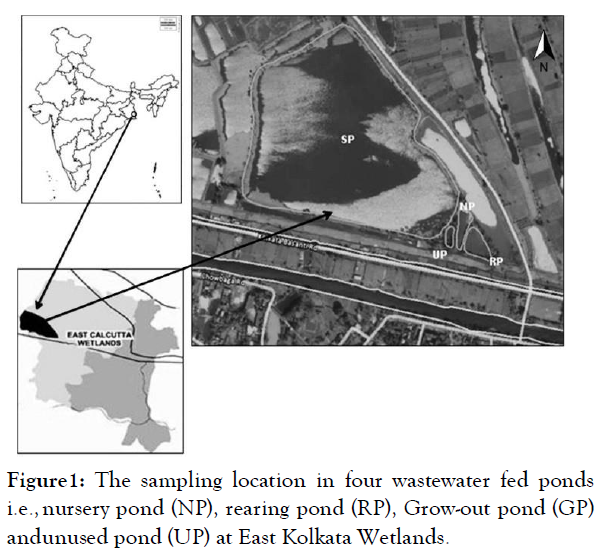
Figure 1: The sampling location in four wastewater fed ponds i.e., nursery pond (NP), rearing pond (RP), Grow-out pond (GP) and unused pond (UP) at East Kolkata Wetlands.
The rearing pond (RP; area 0.13 ha) was used for development of fry to fingerling and the grow-out pond (GP; area 13.3 ha) was used for the development of yearlings or table sized fish. In addition, a pond was selected where no fish were stocked (UP; area 0.07 ha). Absence of fish in this pond offered an opportunity to emphasize on the release of any top-down control by fish on the thriving zooplanktonic communities. About 80% of total fry at NP were transferred to RP (during early pre- monsoon), however, rest were allowed to grow up to fingerling stage in NP only. The fry to fingerling stage of fish development mainly occurred in RP. Majority of the developed fingerling (about 70%) in RP were transferred to GP during late monsoon, however, the rest of the developing fingerling remained in RP and were periodically transferred to GP. Periodic harvesting of yearling was undertaken from GP and supplied to the market [4]. Raw wastewater was allowed to enter every day for 8-10 hours in the GP to provide required nutrient for fish as size of fish were large. Excess pond water from GP was drained out through an outflow channel in order to maintain average depth of approximately 1 m. The pond area, fish size and density were comparatively much less at NP and RP and, thereby, wastewater was allowed to enter twice a week (for 4-5 hours) in these ponds. Since, no fish was stocked in UP, raw effluent intake was allowed only once in a month (for 4-5 hours) to maintain the nutrient balance. Raw wastewater at the ponds was sourced from the SWF channel. RP, NP and UP were also connected with GP through small connecting channels (about 20 cm diameter), guarded by sluices, which were used rarely by the fishermen for drawing water from GP to maintain desired depth of the ponds. However, the connecting channels were not opened during entire sampling period.
Sampling frequency and duration
Samples were collected from each pond once in a month (preferably in the first week) at 6 hrs, 12 hrs and 18 hrs for two successive years (September 2015 to October 2017). Utmost care was taken to avoid stirring in sampling surface water (not more than 30 cm from the surface) from nearly 2 m away from the earthen embankment at 5 – 10 different sampling spots, spaced between 10 m, at each site depending on the size of the pond. Mean data represented the conditions of the respective month and study site. For the sake of easier representation and discussion, yearly data, where necessary, were grouped into four characteristic seasons, experienced in West Bengal, India, namely pre-monsoon (March-May), monsoon (June-August), post- monsoon (September-November) and winter (December- February).
Analysis of physico-chemical factors
Electrical conductance (EC), pH, dissolved oxygen (DO), water temperature (WT) were recorded by Multiline P4 (WTW, Germany). Total alkalinity (TA), total hardness (TH) and Cl1– were determined by using Aquamerck field testing kits (E Merck, Germany). BOD520 was determined by respiratory method using Oxitop-IS 6 in BOD thermostat Cabinet TS 606/2 (WTW, Germany) and COD by spectrophotometric method (Perkin Elmer UV-VIS Lambda 25) after digestion in Thermoreaktor (WTW, Germany). Estimation of NO31- and PO43- were also done by Ion exchange chromatograph (Metrohm 761) in the laboratory. Total suspended solids (TSS) were determined gravimetrically after filtration using Mettler Toledo (AB204-S) electronic balance [5].
Plankton sampling
Qualitative and quantitative plankton samples were collected by filtering 50 L of water at three different sampling hours from each randomly selected sampling spot using No. 25 bolting silk cloth plankton-net (with 64μm aperture size and allowing nearly 33% open area). Sample volumes of 50 ml were maintained for all sample bottles for easy quantitative assessment of the plankters. Phytoplankton samples were collected and preserved with Lugol’s solution following Downing and Zooplankton collection, narcotisation, and preservation were made following. Plankton subsamples of 1 ml each were taken in Sedgwick-Rafter counting cell for counting and identification using Leica DMLB2 microscope fitted with Leica DFC320 camera. For phytoplankton and zooplankton counting and identification, Maximum length and width of ten individuals of each available plankter was measured using micrometers and taxon-wisesize range is depicted in Table 1.
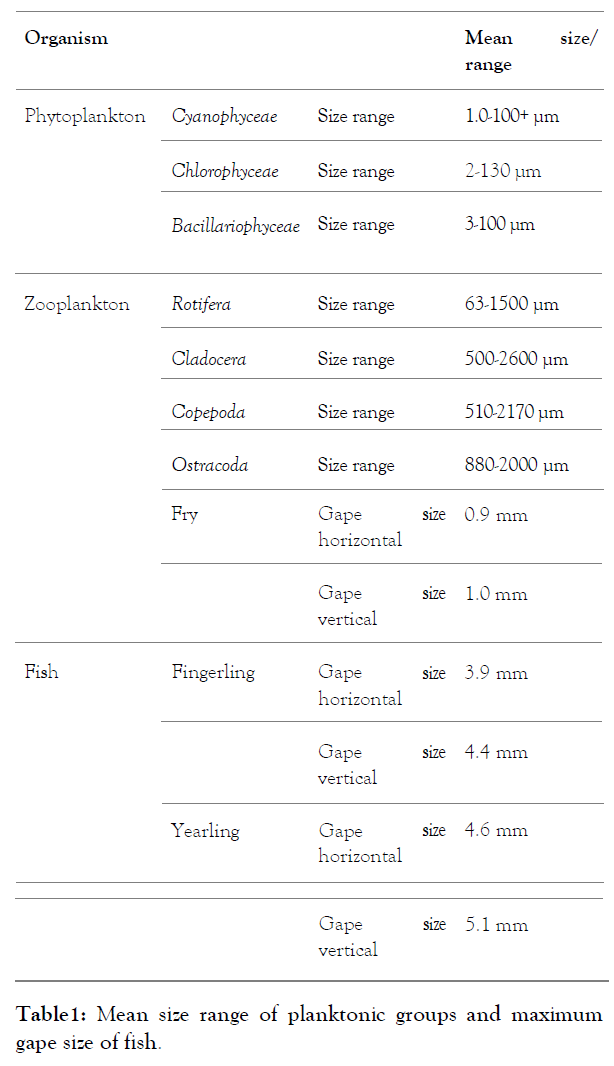
Table 1: Mean size range of planktonic groups and maximum gape size of fish.
Fish sampling
Seine netting was used for sampling of fish following. The net depth (1.5 m) was maintained nearly 1.5 times of water depth as was suggested by as the study ponds were shallow (~ 1.0 m). Approximately one fourth portion of the catch was harvested and weighed and the rest was released at GP. At NP and RP one fourth portion of the catch was weighed and later the whole catch was released to the respective ponds. Fish biomass was approximated in relation to total water volume of the ponds and was expressed as Kg m-3. The sizes of the fish were measured on spot using either a calibrated calipers (Aerospace 0−150 mm) or a steel measuring tape, depending on the size of the fish. Morphometric studies were made on 50 individuals of each fish group (namely carps and cichlids) of each size class available in NP, RP and GP and finally the mean data were considered for discussion. Index of Average Error (IAE) suggested that measurement of total length had significantly lower average errors compared to standard length and fork length for fish species [6-8]. Thereby, in the present study the total length of different size classes of fish was taken into consideration. Total length and mouth gape sizes were recorded by measuring with the aid of steel tape and an electronic digital slide respectively. In certain cases carp and cichlid gape sizes were approximated by using the regression equations.
Community structure and statistical analyses
In order to compare the zooplankton community structures on spatial and temporal scales the diversity indices Shannon Wiener’s Diversity Index (H/), Simpson’s Dominance Index (DSimp), Pielou’s Evenness Index (J/) and Margalef’s Richness Index (DMarg) were calculated by Past 3.0 software [9]. Post hoc (Tukey’s HSD) analysis was employed to compare the degrees of variations in physico-chemical factors and community composition of plankton in the selected ponds by using Statistica for Windows (version 7, Statsoft Inc. 7). Canonical correspondence analysis (CCA) is a multivariate method that is applied to unravel the relationships between biological assemblages and their environments. In the present study, CCA was employed to relate the planktonic groups to their nutritional environment and predation pressure. The statistical significance of eigenvalues and species-environment correlations for the axes generated by the CCA were tested with the Monte Carlo method based on 499 permutations including the unrestricted permutation. CANOCO (version 4.57) software packages were used for CCA analyses. Graphical representations were generated using Origin 2016.
Results
Physico-chemical factors
Table 2 depicts the mean values for different physico-chemical factors. However, UP showed comparable mean physico- chemical conditions with those of NP, RP and GP. Mean WT (varied between 29.1 and 29.4) and pH (7.8 – 8.2) of three wastewater-fed fish ponds were comparable to that of a natural wetland systems where these values were recorded as 30.0 and 8.1 respectively. However, EC (750.0 – 850 μS), TSS (133.9 – 155.2 mg L-1) TH (192.0 – 203.3 mg L-1 CaCO3), TA (331.0 – 416.0 mg L-1 CaCO3), Cl1- (134.6 – 152.5 mg L-1) and PO43- (5.6 – 6.0 mg L-1) were exceedingly higher than the values reported from natural wetlands and smaller uncontaminated freshwater fishponds. NO31- in wastewater-fed fishponds (11.3 – 12.7 mg L-1), were comparable to that of a natural wetlands. Mean BOD520 values ranged between 51.2 and 78.2 mg L-1 and mean COD ranged between 98.0 and 152.1 mg L-1 in the ponds under study. These values were also exceedingly higher than the values recorded from the uncontaminated fishponds. Post hoc analyses pointed out that the ponds under investigation varied significantly (p < 0.05) when compared for physico chemical factors like pH, DO, total alkalinity, nitrate, BOD and COD. Further, mean seasonal variations of physicochemical factors reflected the reduction percentages of 36% BOD, 37% COD, 42% NO2 and 18% PO4 during monsoon months over non-monsoon months (Appendix A).
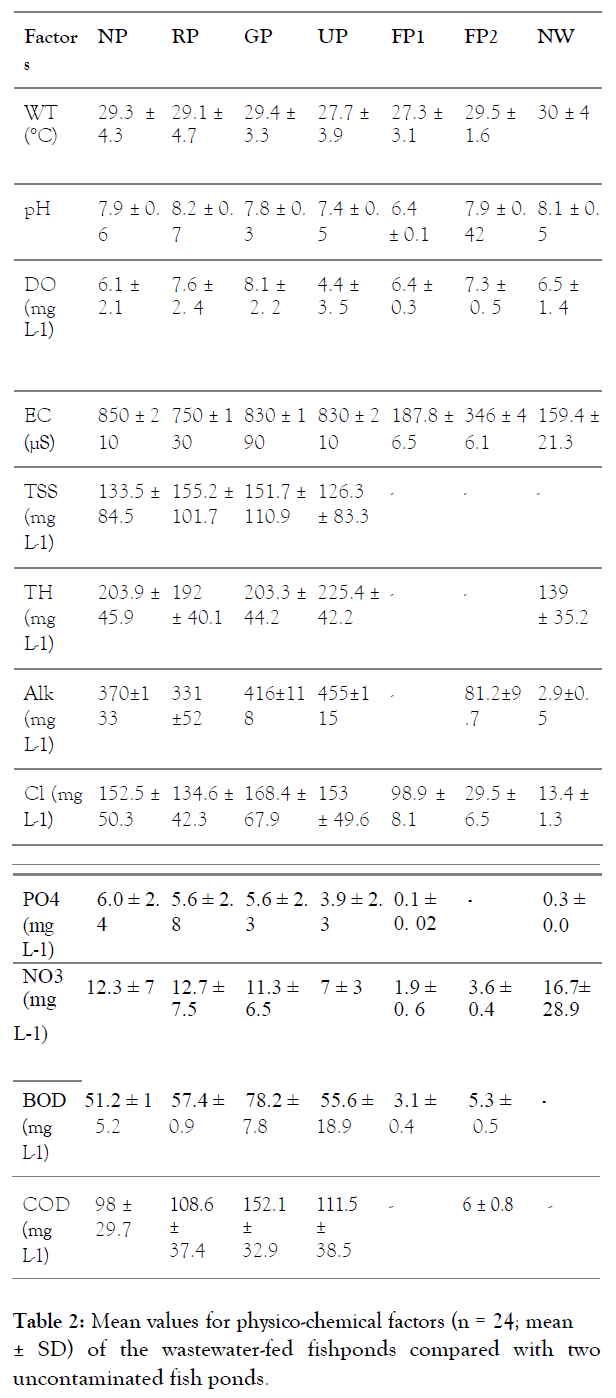
Table 2: Mean values for physico-chemical factors (n = 24; mean ± SD) of the wastewater-fed fishponds compared with two uncontaminated fish ponds.
Zooplankton density, diversity and seasonal variations in the ponds
Depicted seasonal changes in density and diversity of different phyto- and zooplanktonic groups and Appendices II – V depicted such changes for zooplankter species at the ponds under investigation. During two-year study period 48 zooplankton species were recorded in the ponds which included 28 rotifers, 13 cladocerans, 5 copepods and 2 ostracods [10]. GP had greater zooplankton species (42 species) compared to NP, RP and UP (27, 29 and 37 species respectively), however, the mean zooplanktonic density was much lower at GP (118.02 individuals L-1) compared to other ponds (221.25−237.91 individuals L-1). Mean seasonal zooplanktonic densities in the ponds were observed to be generally greater during winter and pre-monsoon seasons compared to monsoon (Figure 2).
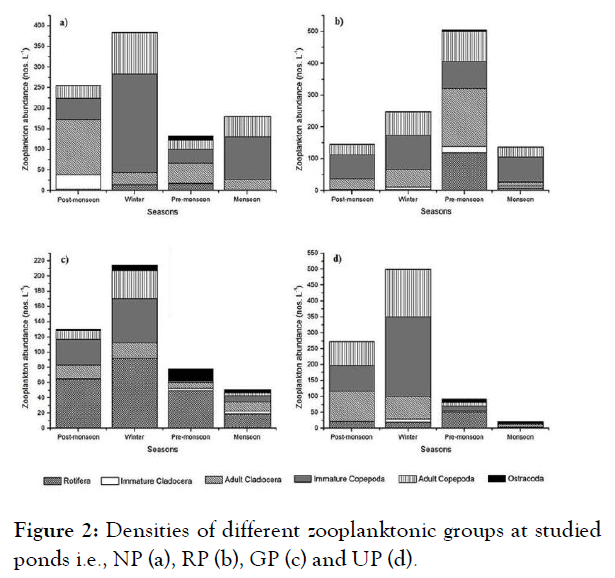
Figure 2: Densities of different zooplanktonic groups at studied ponds i.e., NP (a), RP (b), GP (c) and UP (d).
However, zooplanktonic density in NP was an exception and revealed lowest density during the pre-monsoon. In NP, RP and UP 88-94% of zooplanktonic community were represented by microcrustaceans, while in GP total zooplanktonic community was constituted by 48% rotifers and 52% microcrustaceans. The number of encountered species of zooplankton was lowest during monsoon for NP and UP (9 and 16 species respectively). However, in GP lowest number of zooplankton species was also recorded during winter and monsoon (23 species). Highest number of zooplankton species was recorded during winter in NP (18 species), during post-monsoon in UP (26 species). However, in GP highest number of zooplankton was also found in post- and pre-monsoon months (28 species). RP, on the other hand, showed highest number of species during post-monsoon (19 species) and lowest during winter and monsoon (14 species). The dominant zooplanktonic species in NP and RP were Thermocyclops hyalinus, Mesocyclops leuckarti, Moina micrura, M. brachiata, Heliodiaptomus viduus. In GP, Asplanchna spp. different Brachionid rotifers were also dominant along with the dominant microcrustaceans like T. hyalinus, M. leuckarti, M. micrura and M. brachiata. On the other hand, UP exhibited the dominance of Ceriodaphnia cornuta along with Asplanchna spp., M. leuckartii, M. brachiate and M. micrura [11].
Nursery pond: Rotifers showed highest density during pre- monsoon. The cladocerans exhibited post-monsoon dominance while monsoon showed least density. The copepod densities were highest during winter, followed by monsoon, post- monsoon and pre-monsoon. Immature copepods constituted a major portion (approximately 68%) of total copepod population showing maximum density during winter and minimal during pre- monsoon. Seasonal densities of individual zooplanktonic species were presented in Appendix B.
Rearing pond: Highest density of rotifers in RP was recorded during pre-monsoon while densities were low for other seasons (Appendix C). Cladoceran density showed pre-monsoon dominance primarily due to very high pre-monsoon density of copepod densities were high during winter and pre-monsoon and comparatively low during monsoon and post-monsoon. Immature copepods constituted a major portion (approximately 60%) of the copepod population and showed dominance during winter season.
Grow-out pond: GP showed maximum rotifer density during winter and minimum during monsoon (Appendix D). Cladoceran and copepod densities were lowest during pre- monsoon that increased gradually through the monsoon, post- monsoon and winter. Immature copepods constituted approximately 63% of the total copepod population and showed dominance during winter and reduced densities during pre- monsoon and monsoon. Densities of calanoid copepods at all seasons were found to be very low [12].
Unused pond: The rotifers showed high density during pre- monsoon and low density during monsoon. Cladoceran density exhibited post-monsoon and winter dominance primarily due to very high density of C. cornuta (Appendix E). Copepods densities were considerably high during winter and low during pre-monsoon and monsoon. UP also recorded reduced density of calanoid copepods in all seasons.
Comparison between the zooplanktonic communities in different ponds Shannon Wiener’s Diversity Index (H/) and Margalef’s Richness
Index (DMarg) calculated with the pooled zooplanktonic data for all seasons showed highest values in GP (2.49 and 5.34 respectively) and a decreasing trends in these indices was noted as GP > UP > RP ≈ NP (Fig. 3). Pielou’s Evenness Index (J/) and Simpson’s Dominance Index (DSimp) were found to be comparable between the ponds with values ranging between 0.62-0.67 and 0.14-0.17 respectively (Figure 3).
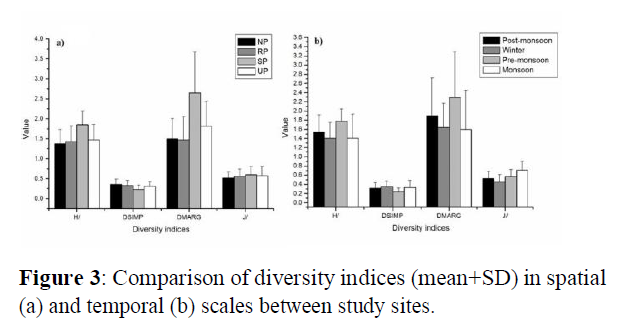
Figure 3: Comparison of diversity indices (mean+SD) in spatial (a)and temporal (b) scales between study sites.
Seasonal trends of H/ and DMarg values for NP and RP showed highest values during pre-monsoon and lower during winter and monsoon (Figure 4).
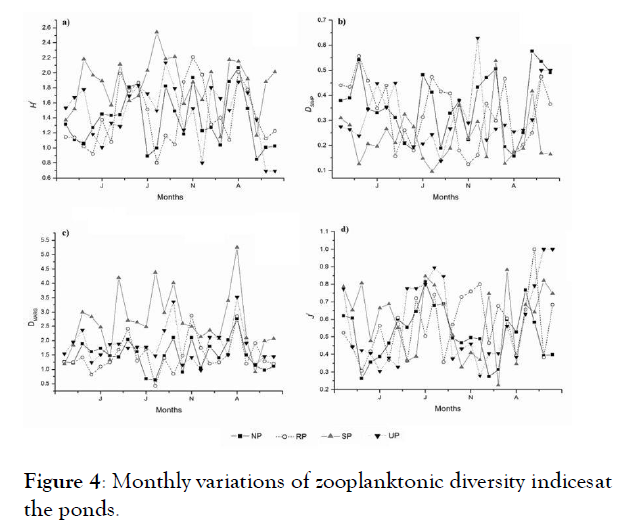
Figure 4: Monthly variations of zooplanktonic diversity indices at the ponds.
In GP, H/ and DMarg values were lower during winter while the other seasons showed higher values. In UP, H/ and DMarg values showed higher values during pre-monsoon and post- monsoon while lower values during winter and monsoon. DSimp values, showed a reverse trend with higher values during winter and lower during rest of the seasons for RP, GP and UP. In NP higher DSimp values were noted during monsoon and lower during pre-monsoon. J/ values were lowest during winter in all the ponds. The Post hoc analysis results showed NP, RP and UP were significantly differ (p<0.05) with GP for H/, DMarg and for DSimp, GP is significantly differ with NP and RP.
Interactions of zooplankton with phytoplankton and fish in the ponds
The nursery nurturing at NP involved 72-96 hours old carp spawn or post-larvae (6.2 ± 0.21 mm) that just began to eat and continued for a period of 20–30 days, during which they grew to fry of about 27.1 ± 0.72 mm (mean horizontal and vertical mouth gape sizes were recorded as 0.9 mm and 1.0 mm respectively). These carp fry were further reared in RP for a period of 2–3 months to raise the fingerlings of about ~100 mm in size (mean horizontal and vertical mouth gape sizes were recorded as 3.9 mm and 4.4 mm respectively). Fingerlings grew in GP for next 9–10 months to grow to yearling (374.7 ± 0.31 mm having mean horizontal and vertical mouth gape sizes as 4.6 mm and 5.1 mm respectively). Cichlid post-larvae were also reared in NP to grow into fry (18.8 ± 0.07 mm) which were then transferred to the RP to grow into fingerlings (46.9 ± 0.07 mm ) and ultimately these were transferred into GP to grow into marketable yearlings (158.9 ± 0.02 mm). Saoud et al. (2005) reported a period of accelerated growth in cichlids that began at hatching and last for roughly 240 days, or 34 weeks [13].
Monthly variations of total phytoplankton, zooplankton and fish densities at the ponds during the study period. A positive correlation was noted between total zooplankton and phytoplankton for RP and GP while negative correlation was noted for NP and UP. Significant positive correlations of total phytoplankton with total zooplankton, cladocera and rotifers in RP (r= 0.462, r= 0.506 and r= 0.498 respectively; significant at < 0.05) and with rotifers in UP (r= 0.409; significant at < 0.05) were recorded (Table 3).
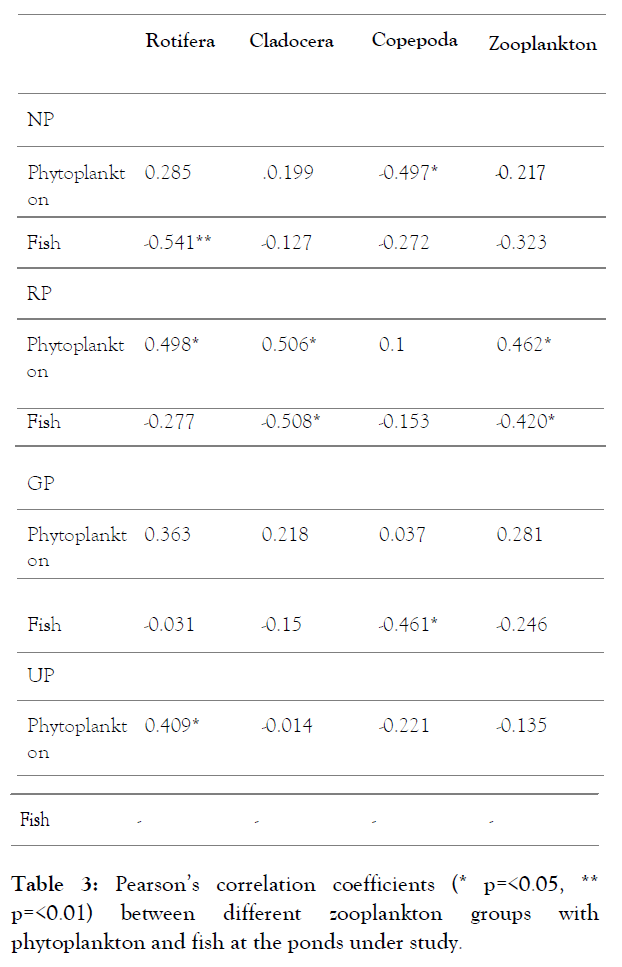
Table 3: Pearson’s correlation coefficients (* p=<0.05, ** p=<0.01) between different zooplankton groups with phytoplankton and fish at the ponds under study.
The copepods were found to be negatively correlated with total phytoplankton for NP (r= −0.497; significant at <0.05). Fish densities in the ponds were found to be significantly negatively correlated with rotifer density for NP, cladoceran and total zooplanktonic densities for RP and copepod density for GP. Results of Post hoc analyses showed that the ponds under investigation varied significantly (p < 0.05) when compared for zooplankton community structures, especially for the abundance of matured copepods and rotifers. CCA plots for NP, RP, GP and UP strongly suggested that nutritional factors like PO4, NO3 and TSS together with fish population significantly influenced the phytoplankton and zooplankton groups. Application of forward selection using the Monte Carlo test confirmed that the first two axes were highly significant (p < 0.05) (Table 4). Multiple environmental variables (e.g., PO4, NO3 and TSS) together with fish predation played a significant role in influencing different groups of plankters.
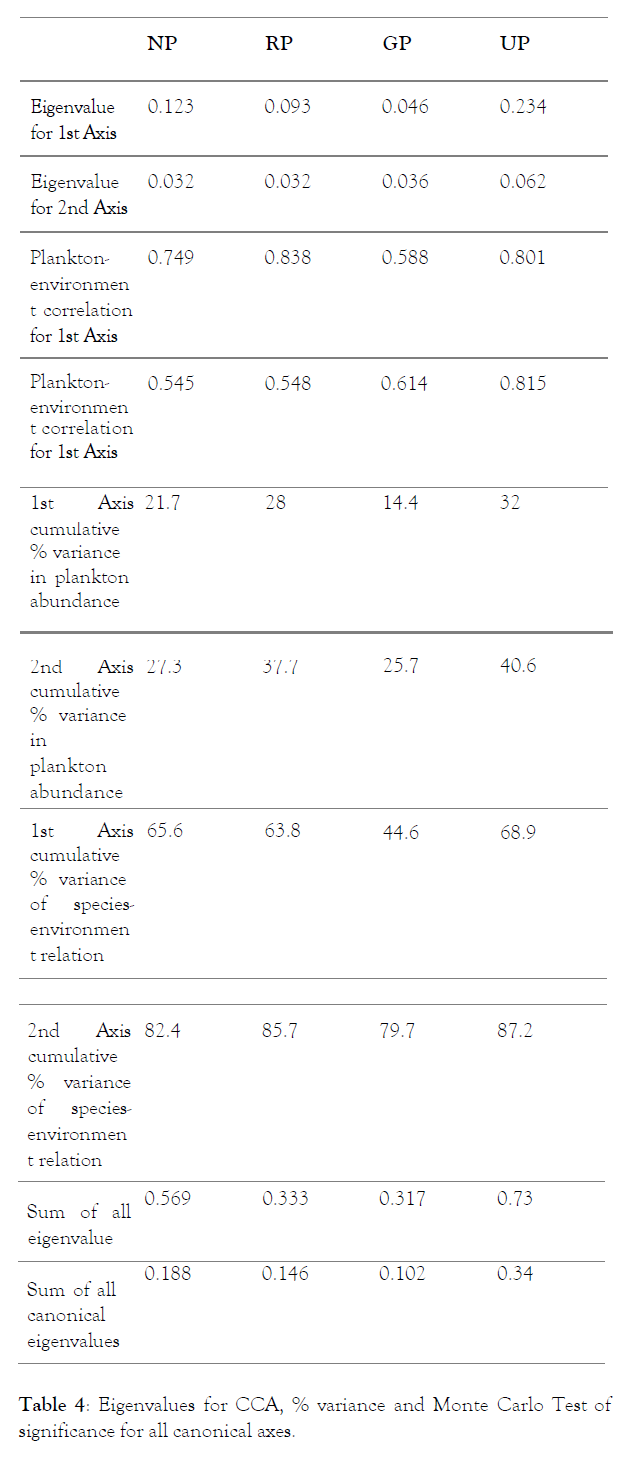
Table 4: Eigenvalues for CCA, % variance and Monte Carlo Test of significance for all canonical axes.
Discussion
Dynamics of physico-chemical factors
Suitable physico-chemical conditions and nutrient regime were main determinants for survival and growth of fish food organisms and subsequently for wellbeing of fish. Composite city wastewater in the present study provided nutrition to the nursery, grow out and grow-out ponds, enhancing natural phytoplankton, zooplankton and benthic fish food sources, having economic benefits. However, mean values for different physico-chemical factors were much higher in the wastewater-fed study ponds compared to uncontaminated fishponds and natural wetland system reported that inadequate wastewater supply was identified as a limiting factor for these ponds stocked with various maturity classes and combinations of indigenous and exotic fish. It may be pointed out that the water quality was not constant; varied with the time of the day, season, weather conditions, water source, and soil type, temperature, stocking density, and feeding rates of fish and culture systems. For successful aquaculture practices, the dynamics and management of water quality must be taken into consideration. The levels of temperature as 28-320C, pH between 6.5 and 9, DO level >5 mg L-1, TH 30 -180 mg L-1 (CaCO3), Alkalinity above 20 mg L-1 and less than 400 mg L-1 (CaCO3), were essential to support good plankton production and fish growth. It also suggested the acceptable levels of EC 100 - 2,000 μS cm-1, TSS 25 - 150 mg L-1 and maximum Cl content as 100 mg L-1 in the waters for fish culture. The optimum nitrate concentration for carp culture was < 80 mg L-1 and commented that nitrate was relatively nontoxic to fish and not cause any health hazard except at exceedingly high levels (above 100 mg L-1). They also recorded the optimum hardness for aquaculture in the range of 40 to 400 mg L-1 (CaCO3). Present study recorded mean values for these factors within or around to these specified safe ranges of concentrations. This was only possible for the controlled wastewater feeding to these ponds by the village artisans basing on their empirical observations. Their efforts since 1939 turned the wastewater-fed pisciculture sustainable at the EKW areas for past eighty years. Although phosphate concentrations exceeding 0.020 mg L-1 were considered eutrophic, yet no such condition developed in the present study ponds despite much higher phosphate concentrations (5.6 – 6.0 mg L-1) were recorded possibly for trophic cascade (Hodgson 2005). However, reported that phosphates were not toxic to fish, unless they were present in very high levels. Quality standards on phosphorous levels (in different forms) set by Australia, ASEAN, Malaysia, New Zealand, Norway, Philippines and United States, are between 0.02 and 0.20 mg L-1 for natural freshwater reported that according to multiple regression analysis BOD, inorganic N and PO43− were responsible for 60–80% variations of fish growth in a wastewater-fed polyculture fish pond, which suggested that organic matter and nutrients in ponds affected fish growth through the food web developed in ponds. In the present study the GP had higher BOD and COD values compared to other ponds and despite such factors this pond had larger numbers of rotifer species and density were in compliance to observations recorded by other workers. Highest mean BOD and COD values were recorded at GP might have allowed large number of opportunist rotifers (25 species) to flourish at GP.
Phytoplankton dynamics
Plankton, particularly phytoplankaton, are the major sources of natural food in a fish pond. To optimize fish production in a waste fed pond, the majority of the fish should be filter feeders, to exploit the plankton growth. Phytoplanktonic primary production in many freshwater lakes was limited by nutrients, most commonly nitrogen or phosphorous. Wetlands with large catchment areas received allochthonous nutrient input from the runoff and encouraged phytoplankton growth. Interestingly, the study ponds had varied catchment areas and received controlled allochthonous nutrient input exclusively with composite wastewater. The system reported that due to the influence of nutrient enrichment the growth rate of total phytoplankton increased significantly. Dilution of the receiving wastewater during monsoon reduced the concentrations of nitrate (about 42%) and phosphate (about 18%). Such reductions in the concentrations of major nutrients for growth of primary producers was reflected by reduced density of phytoplankton (about 58%) at the ponds during monsoon compared to the drier seasons.
Phytoplankton was considered as the primary food for most zooplankton, especially for herbivorous rotifers and cladocerans. It is reported that in freshwater systems total zooplanktonic density might increase with phytoplankton density recorded a significant correlation between total zooplankton and phytoplankton densities. They also referred that phytoplankton community influenced the zooplanktonic community by way of bottom-up control through food and feeding interactions. A lag in phytoplankton peak abundance behind the peaks of zooplankton was evident in the present study at different times during study period. Such hysteresis was reported by and it could be suggested that phytoplankton showed delayed response to predation pressure by zooplankton and fish. Also reported that producer biomass in a freshwater plankton community was reduced due to top-down control. Thus, there existed two distinct regimes, one in which both phytoplankton and phytoplanktivore zooplankton were over-grazed (controlled) by such zooplankton were relatively under-grazed (unaffected) by planktivore fish. Despite higher grazing pressure of phytoplanktivore zooplankters, phytoplankton densities were much higher during nutrient rich winter, pre- and post-monsoon seasons. Grazing by rotifer and nauplii dominated communities is known to be weak, impacting only small cells. The studied a warm temperate wetland where phytoplankton appeared to be controlled by nutrient-input (bottom-up) while fish exerted a strong predation pressure on zooplankton (top-down). In the present study, reduced nutrient availability during monsoon due to dilution negatively affected the phytoplankton density. Low primary productivity and much less diversity and abundance of phytoplankters during monsoon period. Such reduction in food source for grazing zooplankton might have exerted bottom-up control on the zooplankton in the present study. Dryer winter, pre- and post-monsoon was associated with entry of comparatively concentrated, nutrient rich wastewater in the fish ponds. High nutrient content in the wastewater resulted in increased density of phytoplankton and in turn increased the density of the zooplankton. It was thus evident that phytoplankton community exerted a bottom–up control on the zooplankton during monsoon in the wastewater-fed fish ponds, especially in the ponds that nurtured fish with smaller gape sizes (NP with fish larvae).
Zooplankton dynamics
Traditional pond preparation activities were undertaken occasionally, usually once in three years, for these wastewater-fed fish ponds during pre-monsoon. The preparation involved stirring of pond bottom and addition of lime. During late pre- monsoon period, with the addition of a few first showers, fish spawns and hatchlings were introduced. Till 1985, farmers had to depend on natural or local hatcheries at North and south 24- Parganas, and Hooghly districts of the state of West Bengal for seasonal fish seeds. From 1998-99 to 2012-13 there was a two- fold escalation of year-round fish seed production in West Bengal from an initial of 8610 million fish seed production. Certified species-wise fish seeds were also made available round the year from the hatcheries of West Bengal and Andhra Pradesh. These activities induced proliferation of fish spawn in NP with the onset of monsoon. The effect of planktivore fishes with different feeding behavior and biomass levels on plankton. A period of accelerated growth in cichlids that began at hatching and last for roughly 240 days, or 34 weeks when their active predation on minute zooplankton were on record. The food particle sizes suitable for commencement of feeding for silver carp larvae (50–90 μm), for grass carp larvae (90–150 μm) and for bighead carp larvae (150–270 μm). Accordingly exotic carp species fed on moving rotifiers and nauplii. In the present study the recorded mean size classes for indigenous and exotic carp species and cichlids and their gape sizes which were in conformity with the records. That small gape of zooplanktivore larval fish limits their prey size; yet, within constraints set by gape, zooplankton size eaten influences larval growth and ultimately survival. Developing fish fry at NP fed on the zooplankton, especially rotifers, owing to their small mouth sizes. Significant negative correlation (r = − 0.54; p <0.01) between rotifer densities and fish fries observed in NP supported predation pressure on rotifers by juvenile fish. Feeding of rotifers by fish fry during most part of pre-monsoon reduced the density of the former during that season. In addition to fish predation, high density copepods at NP particularly the cyclopoid copepods, which were known to predate upon rotifers, possibly increased predation pressure on the thriving rotifer community. Feeding success on evasive copepod prey was low in larval fish. Relative density of rotifers on an average were thus, minimal in NP (3.69%), compared to cladocera and copepod percent densities (28.98% and 65.99% respectively). During monsoon growing fishlings were transferred from NP to RP. This activity reduced predation pressure on zooplankton in NP and rotifer density gradually increased during monsoon through winter. Contrastingly, RP showed reduced zooplanktonic densities during late monsoon possibly due to predation by fish. In RP, fish sizes were larger (matured fry through fingerling stages) which in addition to rotifers, fed upon the micro-crustaceans too. A significant negative correlation of fish with cladocera and total zooplankton amply supported such prey-predator interactions in RP. With the increase of fish biomass, cladocerans and copepods were decreased, however, rotifers, primary productivity, chlorophyll a, different primary producers like green algae, diatoms were increased. Fingerlings selected larger species of zooplankton than fish fry as their mouth size increased. Increase in percent densities of rotifers at RP compared to NP could be attributed to the release of predation pressure on the rotifers due to presence of more fingerlings with larger gape sizes preferred larger prey. A rotifer-dominated community developed in the presence of planktivorous fish and a Ceriodaphnia dominated community developed in the absence of fish. With the attainment of fingerling size, fish were transferred from RP to GP. Larger size of fish (grown up fingerling through yearling) in GP fed upon larger zooplankton (copepod and cladocerans) and reduced their densities. The fish had a "top-down" effect on larger zooplankton. However, smaller zooplankton, particularly rotifers, avoided predation (from fish and predatory copepods) and consequently their density increased in GP. Significant negative correlation between fish and copepods in GP justified feeding of larger sized fish on larger zooplankton. Top down control of zooplankton by fish predation and mentioned that the increasing predator size diversity enhanced the strength of top-down control on prey through diet niche partitioning. Presence of fish of different maturity levels (fingerlings and yearlings) pointed out the top-down control on zooplanktonic community by fish predation at wastewater-fed fish ponds that contained larger fish. For NP, RP, GP and UP a total of 27.3%, 37.7%, 25.7%, 40.6% of cumulative variance in plankton were explained by the first two CCA axes with 82.4%, 85.7%, 79.7% and 87.2% respectively of the correlation between plankton abundance and environmental factors together with fish density. Application of forward selection using the Monte Carlo test confirmed that the first two axes were highly significant (p < 0.05). Multiple factors of the ambient water like phosphate, nitrate, TSS, EC and BOD together with fish predation might had played a significant role in influencing different groups of zooplankters. However, the effects of fish on planktonic community structures varied among lake ecosystems and geographic regions depending on the factors such as differences in life history of fish, ontogenetic changes, biotic structure of ecosystems and climate.
Community structure of zooplankton
Absence of fish predation pressure on the zooplankton community allowed only the inter-specific prey-predator interactions between the zooplankters that prevailed in UP. The zooplankton community structure in UP was comparable with that of NP and RP barring presence of a few more species in UP than other two ponds. However, the community structure of UP was contrastingly different than that of GP. This could be attributed to the severe predation pressure exerted by the growing fingerling and yearling on zooplankton at GP where the community showed almost equal abundance of microcrustaceans and rotifers while in UP the zooplankton community was constituted by much higher densities of microcrustaceans than rotifers possibly for the higher predation pressure on tiny rotifers exerted by the predatory microcrustaceans, especially by the copepods. Hunt et al. (2003) reported that at high fish predation caused changes in community structure through trophic casacades and was dominated by rotifers and small copepods, while at lower fish predation the community was dominated by larger microcrustaceans. Such predation impacted changes in community. According to diversity index was more sensitive to rare species whereas Simpson’s dominance index emphasized on common species. H/ was dependent both on species richness and abundance showed highest value for GP and lowest for NP. Higher diversity, evenness and lower dominance values in GP were primarily due to presence of many rare zooplanktonic species especially rotifers which probably survived the predation pressure owing to their small size. Our findings were corroborated on the impact of fish predation on zooplankton size structure. Community structure of zooplankters at NP and RP were different owing to rearing fish of different development stages, however, zooplanktonic diversity indices between NP and RP were not significantly different. Additionally UP where zooplanktonic community thrived in absence of fish predation also showed zooplanktonic community structure compared to NP and RP. Diversity indices between the NP, RP and UP were also not significantly different. All the ponds, however, revealed significantly different diversity indices compared to GP. The results suggested that predation pressure of yearlings at GP was more immense in shaping up the zooplanktonic community structure compared to the pressure exerted by smaller sized fish at NP and RP. This was also reflected by low overall mean zooplanktonic density at GP compared to the other ponds. GP with highest BOD and COD showed high zooplanktonic species richness, albeit, least mean abundance. Positive correlation between zooplankton density and BOD. Additionally, GP was the only pond where zooplanktonic community was dominated by rotifers. Rotifers contributed about 47% of the total zooplanktonic density in GP compared to only 3–13% in other three ponds. The number of rotifer species also varied from 11– 19 in other three ponds compared to 25 species in GP. Dominant zooplanktonic species in the study ponds were Moina micrura, M. brachiata, Thermocyclops hyalinus, Mesocyclops leuckarti, Brachionus spp., Asplanchna spp. etc. Rotifers were reported to thrive in greater numbers in wastewaters and considerably helped in ameliorating the polluted environments.
The interpretation of angles in a correlation biplot yielded the correct sign for the correlation but not the correct magnitude, and mentioned that the correlation biplot was correctly interpreted via projection. The projections in CCA plots constructed using the data obtained from the ponds under investigation indicated that fish had negative effects on rotifers, immature cladocera and copepod in NP, possibly due predation by fish fry that had small gape size. A contrasting picture was evident at GP where fish negatively affected both immature and adult copepod and cladocera but not rotifers might be for preferred predation by larger fish with much larger gape size. RP, on the other hand, showed negative impact of fish predation on rotifers, immature and adult cladocerans. However, in UP where the planktonic community was not influenced by the fish predation, showed a contrasting CCA plot compared to the plots for other three ponds where fish were reared. In UP, both cladocerans and copepods were positively affected by major nutritional parameters like PO4, NO3 and TSS while the rotifers and ostracodas were under the influence of phytoplankton.
The results suggested that temporal differences in diversity and abundance of different zooplanktonic groups at the ponds were influenced by fish of different size-class by the way of top-down control exerted by fish with larger gape sizes that preferred larger prey while a bottom-up control exerted by phytoplankton where diminutive fish fry with tiny gape sizes preferred smaller zooplankters. However, during monsoon when the nutrient conditions in wastewater-fed fish ponds did not support a high phytoplankton density due to dilution of nutrient inputs, the reduction in food source might had exerted bottom-up control on the grazing zooplankters, especially in the ponds that contained either no fish or fish with tiny gape sizes.
Conclusion
Kolkata city wastewater together with storm water runoff sustainably supported both blue and green infrastructure at EKW. Hot and humid climate, with abundant rainfall (mean rainfall 1600 mm Y-1 mainly within June to September) and solar radiation (250-600 cal cm-2 d-1), degradation of organic wastes in urban wastewater was fast through decomposer activities. The EKW ecosystems at the urban–rural fringe were significantly important in sequestering carbon, However displayed varied landscape services, with recreation, dumping of recyclable wastes and renewable organic solid waste at the urban end, while agriculture and pisciculture in the rural outer zone. reported that urbanization brought about changes in peri-urban use of agriculture and aquaculture areas which, in turn, affected the spatial pattern of ecosystem service delivery. The total EKW area of 81 km2 in 1945 with 47 km2 area of sewage–fed fisheries has been decimated today to 51 km2 of wetland area, covering only 12 km2 fisheries area. Even after nearly 37% shrinkage in wetland area and a nearly 75% reduction in aquatic system, EKW yielded 11.4% of the total annual supply of fish for India.
scientists’ have been able to facilitate three major practices - sewage treated fisheries, garbage farming and sewage farming. These activities prove to be economically sustainable for the people dependent on them for their livelihoods as well as for future use. This type of indigenous technology reflected the idea of environmental sustainability envisioned in Output/Input Rules of Daly and Goodland, which states, “keep wastes within assimilative capacities; harvest regenerative capacities of renewable resources". The phrase ‘indigenous technology and knowledge’ referred to any cultural strategy developed by a society to survive within the constraints of their environment. These constraints included the physical environment, meaningful societal hierarchy of labours and administration and adaptability to changing circumstances. Cheap, hard-working workforce together with an abundant wetland area successfully converted waste into wealth for nearly the past hundred years without any investment made for installing and running sewage treatment plants and thereby Kolkata has been designated as an ecologically subsidized city.
Conflicts of Interest
The authors have no conflicts of interest to declare.
Acknowledgments
Authors are thankful to Prof. Sanjoy Chakraborty, Principal and Dr. Anjan Biswas of Government College of Engineering and Leather Technology (GCELT), Kolkata-700106 for cooperation and necessary infrastructural support. Authors are thankful to DHESTBT, Government of West Bengal for Junior Research Fellowship and to the University Grants Commission for Emeritus Fellowship that helped in completing this work.
REFERENCES
- Adhikari S, Goswami AR, Mukhopadhyay SK. Diversity of zooplankton in municipal wastewater contaminated urban pond ecosystems of the lower Gangetic plains. Turk J Zool. 2017;41:464-475.
- Aguilera X, Declerck S, Meester LD, Maldonado M, Ollevier F. Tropical high Andes lakes: A limnological survey and an assessment of exotic rainbow trout (Oncorhynchus mykiss). Limnologica 2006;36:258-268.
- Akhurst DJ, Jones GB, Clark M, Reichelt-Brushett A. Effects of fish and macrophytes on phytoplankton and zooplankton community structure in a subtropical freshwater reservoir. Limnologica. 2017;62:5-18.
- Battish SK. Freshwater Zooplankton of India. Oxford and IBH publishing, New Delhi. 1992.
- Bhatnagar A, Devi P. Water quality guidelines for the management ofpond fish culture. International journal of environmental sciences. 2013;3:1980-2009.
- Blair JM, Hicks BJ, Pitkethley R, Ling N. Diet of rainbow trout in Lake Rotoiti: An energetic perspective. New Zeal J Mar Fresh. 2012;46:557-565.
- Buckley B. Seine Netting, Advisory Booklet from the Specialist Section-Management, Publications of the Institute of Fisheries Management, Nottingham. 1987.
- Bunting SW. Appropriation of environmental goods and services by aquaculture: a reassessment employing the ecological footprint methodology and implications for horizontal integration. Aquat Res. 2001;32:605-609.
- Dabrowski K, Bardega R. Mouth size and predicted food size preferences of larvae of three cyprinid fish species. Aquaculture.1984;40:41-46.
- Das D, Pal S, Keshri JP. Environmental determinants of phytoplankton assemblages of a lentic water body of Burdwan, West Bengal, India. Int J Cur Res Rev. 2015;7:1- 7.
- Kumar D, Karthik M, Rajakumar R. Study of seasonal water quality assessment and fish pond conservation in Thanjavur, Tamil Nadu, India. J Entomol Zool Stud. 2017;5:1232-1238.
- Ejsmont-Karabin J. An analysis based on rotifer indices of the effects of water and sewage management on water quality in the system of interconnected glacial lakes. Limnol Rev. 2013;13:191-195.
- Ghosh A, Mohapatra BK, Roy AK. Relationship between Fish Seed Production and Inland Fish Production of West Bengal, India. SM J Biomet Biostat. 2017;2:1013-1015.
Citation: Mukhopadhyay SK, Goswami AR, Adhikari S, Pal S (2021) Fish Mediated Plankton Community Dynamics at Wastewater-Fed Fish Ponds: A Sustainable Bio Resource Management at East Kolkata Wetlands, a Ramsar Site (No. 1208). Int J Waste Resour.11:405.
Copyright: © 2021 Goswami AR , et al. This is an open-access article distributed under the terms of the Creative Commons Attribution License, which permits unrestricted use, distribution, and reproduction in any medium, provided the original author and source are credited.

